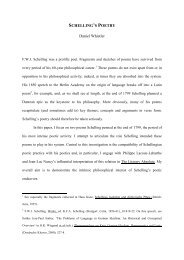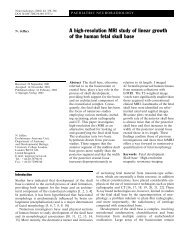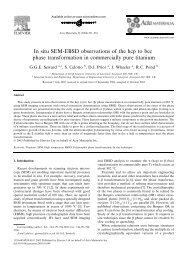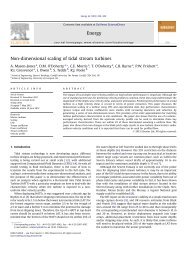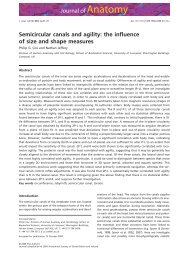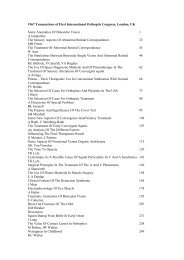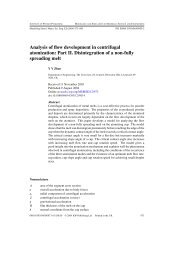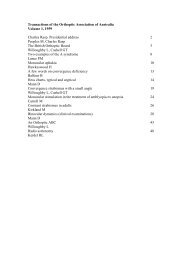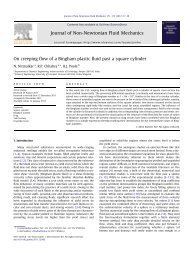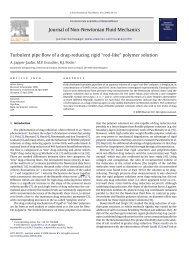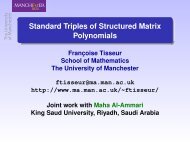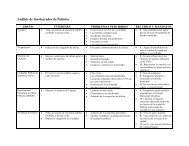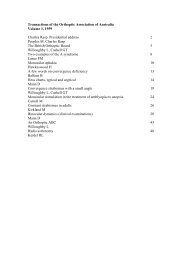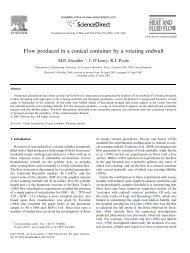Beyond the Pre-Pottery Neolithic B interaction sphere - University of ...
Beyond the Pre-Pottery Neolithic B interaction sphere - University of ...
Beyond the Pre-Pottery Neolithic B interaction sphere - University of ...
You also want an ePaper? Increase the reach of your titles
YUMPU automatically turns print PDFs into web optimized ePapers that Google loves.
120 J World <strong>Pre</strong>hist (2006) 20:87–126<br />
probably represented <strong>the</strong> material and social outcomes <strong>of</strong> a whole spectrum <strong>of</strong> tensions<br />
operating at multiple levels and among multiple agents: between mobile hunter-ga<strong>the</strong>rer<br />
and settled cultivator–herder or pastoral lifestyles; between households as loci <strong>of</strong> production<br />
and reproduction, and communities as corporate units; between group ancestors<br />
venerated in community ceremonies and emergent ‘‘private’’ family genealogies (Asouti,<br />
2005).<br />
From such a viewpoint, one might also entertain <strong>the</strong> possibility that <strong>the</strong> appearance <strong>of</strong><br />
‘‘mega-sites’’ towards <strong>the</strong> end <strong>of</strong> <strong>the</strong> PPNB could have embodied inter alia an attempt to<br />
contain similar socio-political paradoxes that, in all probability, formed a recurrent and<br />
defining characteristic <strong>of</strong> Early <strong>Neolithic</strong> social life (Asouti, 2005; Forest, 2003). Communities<br />
<strong>of</strong> this size point to unprecedented levels <strong>of</strong> inter-personal and group <strong>interaction</strong>,<br />
and attendant adjustments in negotiating diverse strategies <strong>of</strong> resource ownership and<br />
exploitation. From this perspective, I consider arguments promoting mutually exclusive<br />
interpretations (such as <strong>the</strong> PPNB world being (semi)sedentary hunter-ga<strong>the</strong>rers, or its<br />
opposite that <strong>the</strong>re were fully fledged agropastoral economies) as intellectually partial and<br />
potentially misleading. Such arguments project (post)modernist dualisms and preconceptions<br />
onto <strong>the</strong> prehistoric past. Comparative analysis <strong>of</strong> <strong>the</strong> diverse political economies and<br />
habitual practices characterizing <strong>the</strong> Early <strong>Neolithic</strong> societies <strong>of</strong> Western Asia is necessary<br />
not only as a device for constructing plausible historical narratives and <strong>the</strong>oretically<br />
accomplished arguments, but also as a requisite for a meaningful understanding <strong>of</strong><br />
<strong>Neolithic</strong> ritual/symbolic expression, social and territorial organization, and subsistence/<br />
craft production in <strong>the</strong>ir local and regional contexts.<br />
Acknowledgements I would like to thank here Douglas Baird, Angela E. Close, Bill Finlayson, Ian Kuijt,<br />
Louise Martin, Mark Roughley and David Wengrow for stimulating my thinking through conversation,<br />
constructive argument and <strong>the</strong> critical assessment <strong>of</strong> several issues discussed in this article. Angela Close,<br />
James Phillips and several anonymous reviewers <strong>of</strong>fered substantive editorial comments and constructive<br />
criticism for which I feel enormously indebted. Mark Roughley assisted with <strong>the</strong> editing <strong>of</strong> <strong>the</strong> illustrations.<br />
Ian Hodder and <strong>the</strong> Çatalhöyük Research Project (special thanks are due to <strong>the</strong> site director, Shahina Farid)<br />
facilitated access to <strong>the</strong> unpublished objects presented in Figs. 11, 12. My research has benefited substantially<br />
from <strong>the</strong> intellectual environment provided by <strong>the</strong> Çatalhöyük Research Project for <strong>the</strong> better part<br />
<strong>of</strong> <strong>the</strong> last 10 years, and several conversations and exchanges with project members and o<strong>the</strong>r colleagues in<br />
Turkey and elsewhere (too many to mention here by name!) I reserve for myself <strong>the</strong> responsibility for any<br />
remaining mistakes, omissions and inaccuracies.<br />
References<br />
Abbès, F., Atlı, N. B., Binder, D., & Cauvin, M.-C. (1999). Etude téchnologique préliminaire de l’industrie<br />
lithique d’As¸ıklı Höyük. TU¨BA-AR, 2, 117–137.<br />
Abbès, F., Bellot-Gurlet, L., Cauvin, M.-C., Delerue, S., Dubernet, S., Poupeau, G., & Stordeur, D. (2003).<br />
Provenance <strong>of</strong> <strong>the</strong> Jerf el Ahmar (middle Euphrates valley, Syria) obsidians. Journal <strong>of</strong> Non-Crystalline<br />
Solids, 32, 162–166.<br />
Ammerman, A. J., & Cavalli-Sforza, L. L. (1984). The <strong>Neolithic</strong> transition and <strong>the</strong> genetics <strong>of</strong> populations<br />
in Europe. Princeton: Princeton <strong>University</strong> <strong>Pre</strong>ss.<br />
Andrews, P., Molleson, T., & Boz, B. (2005). The human burials at Çatalhöyük. In I. Hodder (Ed.),<br />
Inhabiting Çatalhöyük: Reports from <strong>the</strong> 1995–99 seasons (pp. 261–278). Cambridge: Çatalhöyük<br />
Research Project 4, British Institute <strong>of</strong> Archaeology at Ankara & McDonald Institute for Archaeological<br />
Research.<br />
Asouti, E. (2004). The contribution <strong>of</strong> subsistence archaeology into generating supra-regional models for<br />
understanding Near Eastern Neolithization. <strong>Neolithic</strong>s, 1(04), 23–24.<br />
Asouti, E. (2005). Group identity and <strong>the</strong> politics <strong>of</strong> dwelling at <strong>Neolithic</strong> Çatalhöyük. In I. Hodder (Ed.),<br />
Çatalhöyük perspectives: Themes from <strong>the</strong> 1995–99 seasons (pp. 75–91). Cambridge: Çatalhöyük<br />
123



